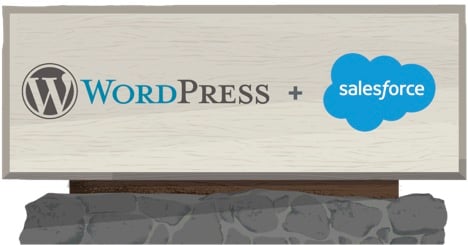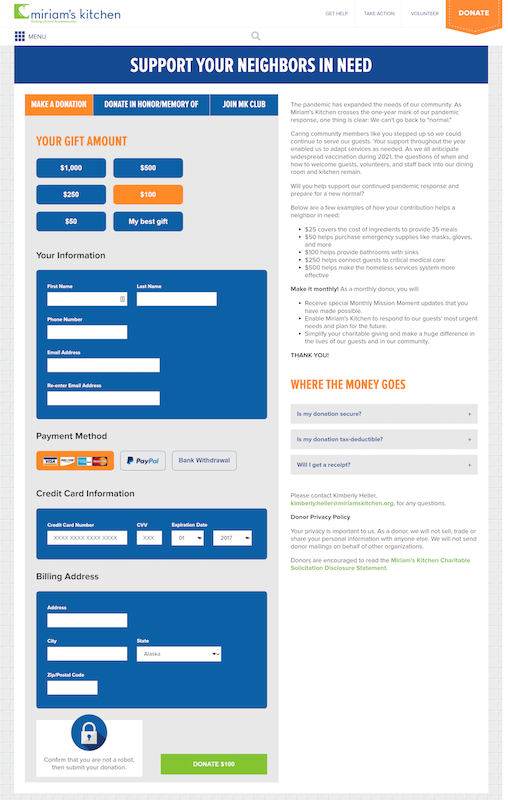Salesforce Web Page Layout Design Tool
*This post was originally published on 12/3/2017, and it was updated on 06/17/2021.
Advice for nonprofits on going from web forms to results

WordPress is the world's most-used Content Management System (CMS), and Salesforce is the leading Customer Relationship Management (CRM) platform. Together they are a powerful set of tools for nonprofits, especially with integrations to automatically sync data between them.
When your website visitors donate, subscribe to your newsletter, or register for an event, that information can be synced directly to Salesforce. Your website can also pull and display data stored in Salesforce, such as lists of sponsors or grantees, program data, chapter or affiliate information, or some other personalized experience based on the visitor's profile.
The initial investment to integrate your website with your Salesforce instance pays off through better data quality and consistency with less staff time spent on data administration.
Here we break down popular integration options depending on your goals and budget, in order from the most simple and inexpensive to the more robust methods that require greater investment to accommodate complex requirements.
Here's what you'll need to do to integrate WordPress and Salesforce:
There are a variety of ways to integrate your WordPress website with Salesforce. Here's a list in order from those that are most simple and inexpensive to the ways that are most able to accommodate complex or custom requirements and more costly:
1) Collect data via forms on your website and capture it in Salesforce…
…as a Lead object
Solution: Web to Lead forms
The native Web to Lead function in Salesforce provides a setup wizard to create a form. Embed the generated HTML on your site, and you have a form that submits the information as a new record in the Lead object.
Pricing and level of effort:
- No licensing costs; included with Salesforce
- Lowest implementation level of effort
Advantages:
- Simple wizard to create a form
- Great for capturing leads/data from a "Contact us" form on a website
Disadvantages:
- Limited to creating Lead records
- Only fields available in the Lead object can be used on the web form
- Salesforce-generated HTML code may require additional styling
…as a different standard or custom object
Solution: Content Management System Form Builders
Unlike web-to-lead tools, these provide the flexibility of submitting data not just to Leads but to other standard or custom objects in Salesforce. These tools provide a combination of point-and-click and drag-and-drop user experiences for simple and fast form building. Add-ons enable you to map form fields to Salesforce fields, generally using a simple graphical user interface (GUI) so you don't have to write any code.
Pricing and level of effort:
- Low annual licensing costs ranging from $50 to $300 depending on the package
- Medium level of effort for implementation
Advantages:
- Active plugins maintain WordPress compatibility and work well with many prebuilt themes. Check the tool's WordPress Plugin Directory listing to see if it has been recently updated.
- GUI user interface makes it fast and simple to build forms
- Data can be inserted into almost all standard and custom objects in Salesforce
- Add-ons and middleware can be used to integrate payment processors for accepting donations, membership dues and other payments
- Basic Payment Card Industry Data Security Standard (PCI-DSS) Compliance with some tools such as Gravity Forms
Disadvantages:
- Requires add-ons or middleware to integrate with Salesforce
Sample Apps or Tools:
- Ninja Forms with Salesforce extension
- Gravity Forms with Zapier
- WP Forms with Salesforce extension
…with more complex needs such as pre-filling users' existing Salesforce data in the form
Solution: Advanced Form Builders
Think of these tools as CMS form builders on steroids. They offer additional features such as pre-filling form fields with Salesforce data via bi-directional integration. Advanced form field building tools enable more complex operations within a form, such as displaying different fields depending on the values of previously completed fields. Similar to the CMS form tools, these tools use a GUI-based system for designing forms and mapping fields.
Pricing and level of effort:
- Higher annual per-user licensing costs ranging from $1K to $8K depending on the package
- Higher implementation level of effort
Advantages:
- Advanced feature sets
- Some options allow for two-way communication between Salesforce and WordPress. The bi-directional sync can be used to pre-fill forms with data from Salesforce.
- Add-ons and middleware can be used to integrate payment processors for accepting donations, membership dues and other payments
- Advanced HIPAA and PCI DSS compliance options available
Disadvantages:
- Requires higher-level coding skills and Salesforce skills to implement
Sample Apps or Tools:
- Form Assembly
- Formstack
2.Integrate third-party services for payments, event registration, email campaigns and more
Solution: Third party services with Salesforce integration
Third party services and apps with Salesforce integration are often included as part of tools like donation or event registration services. The forms often submit data to the service, which then connects to Salesforce through the Salesforce API or through an App from the Salesforce AppExchange.
Pricing and level of effort:
- Low to high annual licensing costs ranging from $120 to $5K depending on the service and package; payment processors and other services often include a fee on a per transaction basis
- Higher implementation level of effort
Advantages:
- Simple, purpose-driven forms
- Salesforce integration can include actions like creating opportunities or assigning campaign members
Disadvantages:
- Limited form building tools
- Additional custom styling on forms is almost always needed
Sample Apps or Tools:
- Donation Forms: Salesforce Elevate, iATS/Brickwork, Stripe, Classy
- Events: Soapbox Engage, Aventri, Cvent, Blackthorn Events, Linvio Events
- Email Marketing: Pardot, MailChimp, Constant Contact
3. Set up a one-way or bi-directional sync between Salesforce objects and WordPress content types…
…and my sync and UX needs are simple
Solution: WordPress Object Sync for Salesforce
Object Sync for Salesforce is an open-source WordPress plugin that provides a GUI to map and sync data between Salesforce objects and WordPress content types. For any supported WordPress content types (e.g., post, page, user, or any custom content type), you can assign Salesforce objects that will be created/updated/deleted when the data in WordPress is saved, and the WordPress objects can be created/updated/deleted when the data in Salesforce is saved. The plugin also facilitates development to further modify the sync for your needs.
Pricing and level of effort:
- No annual licensing costs
- Medium level of effort for implementation
Advantages:
- Each field can be configured for one-way sync from Salesforce to WordPress, or WordPress to Salesforce, or for bi-directional sync between the two
- Development hooks allow for custom code
Disadvantages:
- Best for simple syncs – one Salesforce object to one WordPress post, no filtering within that object type, and simple fields. Custom development is required for more flexibility.
Tool:
- Object Sync for Salesforce
…and my sync or UX needs are more complex
Solution: Custom Integration
If you have more complex needs for your nonprofit CRM and Salesforce integration, you might consider pursuing custom development.
Example use cases for custom development include donation forms that need to include multiple payment processors or send data to multiple campaigns; allowing donors to update their own credit card numbers or mailing addresses ("self-service" functionality); or displaying lists of members, sponsors, or a board of directors from Salesforce onto a website with custom styling. Searchable databases can be created on websites as well, allowing for Salesforce to serve as the system of record for information such as chapter details.
Pricing and level of effort:
- No inherent annual licensing costs, but may involve integrating services such as payment processors that have their own licensing costs
- Highest level of effort for implementation – ranging from $5K to $25K and up depending on the scope of the project
Advantages:
- Ability to manage complex queries and large datasets
- Greatest control over styling and presentation
- Greatest control over Salesforce objects and fields
Disadvantages:
- Requires advanced development skills (PHP or Java) and advanced knowledge of the Salesforce APIs (Rest and SOAP)
- The required skillsets usually necessitate hiring a consultant for initial implementation and future modifications
- Salesforce has API limitations that can be increased with an additional investment
Case Study: Custom integration in action
Miriam's Kitchen, a Washington, D.C. nonprofit dedicated to ending chronic homelessness, needed a custom solution for one-time, recurring, or in-tribute donations. They also wanted to publish unique giving-campaign donation forms and associate the payment to the corresponding campaign in Salesforce. Custom-built templates in WordPress let them use IATS payment processing and Salesforce integration for the contact and opportunity objects.

Conclusion
The right integration method for your organization's needs depends on a variety of factors including:
- Your budget
- The complexity of your data needs
- The importance of branding and consistent user experience on your site
An experienced consultant can help you choose the right integration method and the best apps or third party services to meet your needs.
Find resources that can help you with your Salesforce integration on the Salesforce AppExchange.
About the Co-Authors

Dr. Lisa Rau, co-founder of Fíonta, has over twenty-five years of professional experience in the information technology industry. Dr. Rau is a well-known leader in the nonprofit technology field. She specializes in the development of specific concepts, vision and direction for the strategic use of technology within nonprofits from a holistic, organizational perspective.

Erin Rickard is Fíonta's digital services manager, leading the web design and development practice. With over a decade of experience sitting at both sides of the table – first as a site administrator and content editor, and then as a web project manager – Erin applies her understanding of organizational goals, user needs, and technical requirements to achieving successful projects for nonprofits and associations.
Salesforce Web Page Layout Design Tool
Source: https://www.salesforce.org/blog/integrating-wordpress-salesforce/
Posted by: jacksonackles94.blogspot.com

0 Response to "Salesforce Web Page Layout Design Tool"
Post a Comment